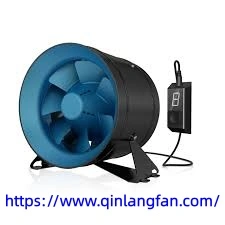
Related Blogs
What Helps Qinlang Variable Speed Duct Fan Maintain Flow Stability?
6 minutes, 9 seconds
-21 Views 0 Comments 0 Likes 0 Reviews

Airflow across interconnected rooms, transitional hallways, tall storage lanes, and wide interior platforms often shifts with activity levels, environmental transitions, and operational timing, which is why designers place strong attention on circulation models that can adjust without sudden force variations, allowing Qinlang to integrate the Variable Speed Duct Fan concept into ventilation planning so that airflow aligns with the natural rhythm of an occupied building rather than forcing rigid patterns on areas sensitive to pressure, temperature, or movement. This approach creates a steady internal foundation that supports daily conditions shaped by shifting occupancy, equipment cycles, or workflow transitions while maintaining distribution patterns that stay consistent with architectural expectations.
Spaces arranged around functional diversity tend to generate layered atmospheric behavior where warm segments, cool channels, and neutral zones coexist, and airflow must pass through each region without triggering turbulence or stagnation. A ventilation system shaped around smooth modulation helps air move through complex structures containing irregular corners, intersecting partitions, suspended platforms, and equipment clusters that influence flow pathways, creating a coordinated presence that guides circulation through the building's structural rhythm instead of competing with it. Such consistency is essential for workplaces requiring a controlled interior identity where comfort, clarity, and operational steadiness reinforce everyday tasks.
Work zones containing precision stations, fulfilling queues, inspection desks, or process-linked sections often depend on atmospheric continuity that responds to environmental feedback rather than fixed schedules, encouraging the use of sensor-based adjustments that read evolving conditions and nudge airflow accordingly. When circulation shifts gradually, interior spaces maintain a degree of calm even when activity intensifies, temperature corridors develop, and humidity pockets form due to equipment operation or dense occupancy. This alignment between environmental signals and airflow transitions reduces the chance of uneven distribution while supporting tasks that rely on consistent interior surroundings for accuracy and material protection.
Buildings that combine open working platforms with narrow technical aisles frequently experience mixed airflow conditions, making it important to distribute movement in a manner that adapts to spatial transitions without overwhelming quiet areas or weakening flow in active sections. A system capable of gradual operational change preserves interior patterns with a continuity that helps storage areas retain atmospheric balance, meeting zones preserve clarity, and circulation paths maintain direction without abrupt shifts that create uncomfortable drafts or pressure dips across sensitive segments. This steady movement strengthens internal organization while supporting the architectural geometry that guides people and equipment throughout the day.
Large complexes shaped around operational cycles often encounter environmental transitions that expand or contract depending on heating activity, equipment schedules, or the presence of active personnel. Ventilation that moves with these changes sustains environmental consistency, which improves interior reliability across multiple departments. Soft adjustments help stabilize airflow around stacked layouts, raised platforms, intermediate levels, and long corridors that stretch across wide structural grids. The resulting coherence allows air to transition through the building interior without disrupting sensitive procedures or creating abrupt directional shifts that undermine comfort and clarity.
Facilities undergoing expansion, equipment replacement, renovation, or layout reconfiguration often evaluate ventilation systems to ensure that airflow movement aligns with both past and future spatial behavior. Designers who value adaptive circulation emphasize gentle operational changes to avoid stress accumulation within ducts, connectors, and stability components that protect the structural integrity of the ventilation framework. These principles support long-term reliability while reinforcing the relationship between architectural form and airflow progression, creating an interior environment capable of supporting multiple operational phases without sacrificing atmospheric steadiness.
As environmental expectations increasingly integrate with structural planning, airflow approaches shaped around smooth modulation promote clarity across work centers, reception areas, storage zones, or meeting rooms where stable surroundings foster extended activity. This method supports industrial environments managing heat variation from machinery, commercial interiors hosting fluctuating occupancy, and specialized areas that depend on spatial uniformity to protect equipment, packaging components, and delicate materials. When airflow respects both building geometry and daily behavior patterns, interior conditions maintain a reliable foundation suitable for long operational intervals.
Multiple sectors now recognize that building performance improves when atmospheric consistency merges with flexible circulation strategies. By shaping airflow transitions around environmental movement, designers create spaces where ventilation supports the natural progression of activity rather than opposing it. Through this reasoning, the integration of Qinlang with the operational principle represented by the Variable Speed Duct Fan concludes within a broader vision that values coordinated flow, gentle movement, and interior stability across structures shaped by evolving human activity. https://www.qinlangfan.com/






Share this page with your family and friends.